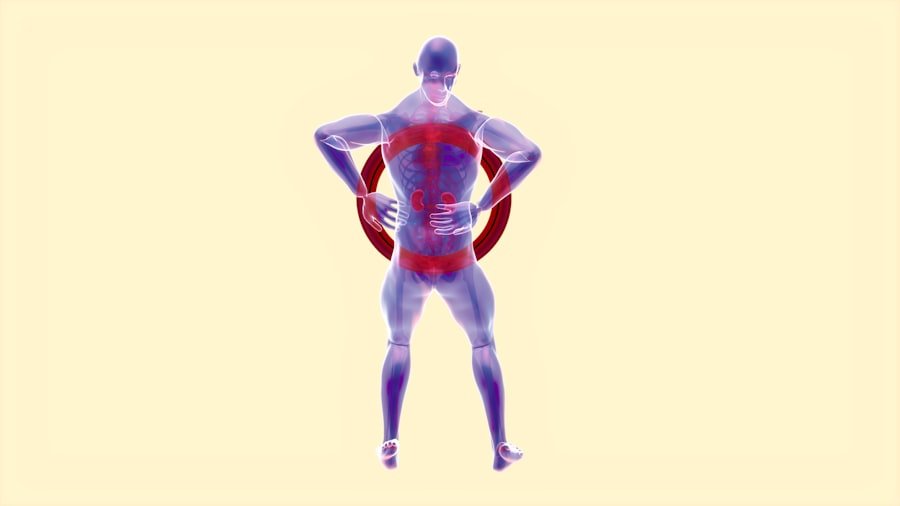When you think about your body composition, it’s essential to grasp the concept of lean body mass (LBM). Lean body mass refers to the weight of everything in your body except fat. This includes your muscles, bones, organs, and water.
Understanding LBM is crucial because it plays a significant role in your overall health and fitness. By focusing on increasing your lean body mass, you can improve your metabolism, enhance your physical performance, and reduce the risk of various health issues. To put it simply, lean body mass is a key indicator of your body’s fitness level.
It reflects how much muscle you have compared to fat. The more lean mass you possess, the better your body can perform daily activities and exercise. This understanding can motivate you to make lifestyle changes that promote muscle growth and fat loss, ultimately leading to a healthier you.
Key Takeaways
- Lean body mass refers to the weight of your body minus the weight of your fat, and it includes muscles, bones, organs, and water.
- Lean body mass is important for overall health, metabolism, and strength, and it can help prevent chronic diseases such as diabetes and osteoporosis.
- Lean body mass can be measured using methods such as dual-energy X-ray absorptiometry (DEXA), bioelectrical impedance analysis (BIA), and skinfold calipers.
- To support lean body mass, it’s important to eat a balanced diet with adequate protein, healthy fats, and carbohydrates, while avoiding excessive processed foods and sugary drinks.
- Regular resistance training, weightlifting, and high-intensity interval training (HIIT) can help build and maintain lean body mass, while also improving overall fitness and metabolism.
The Importance of Lean Body Mass for Health and Strength
Lean body mass is not just a number on a scale; it is a vital component of your overall health and strength. Higher levels of LBM are associated with improved metabolic rates, which means your body burns calories more efficiently. This can be particularly beneficial if you’re trying to lose weight or maintain a healthy weight.
Additionally, having more muscle mass can enhance your physical strength, making everyday tasks easier and improving your athletic performance. Moreover, lean body mass plays a crucial role in preventing chronic diseases. Research indicates that individuals with higher LBM have a lower risk of conditions such as diabetes, heart disease, and osteoporosis.
By prioritizing the development of lean body mass, you are not only enhancing your physical capabilities but also investing in your long-term health. This understanding can empower you to make informed choices about your diet and exercise routines.
How to Measure Lean Body Mass

Measuring your lean body mass can be done through various methods, each with its own level of accuracy and accessibility. One common approach is bioelectrical impedance analysis (BIA), which uses a small electrical current to estimate body composition. This method is often available in gyms or through personal scales designed for home use.
While BIA is convenient, it’s important to note that hydration levels can affect its accuracy. Another reliable method is dual-energy X-ray absorptiometry (DEXA), which provides a detailed breakdown of body composition, including bone density. While DEXA scans are typically conducted in medical facilities, they offer a comprehensive view of your lean mass compared to fat mass.
If you’re serious about tracking your progress, consider consulting with a fitness professional who can guide you through these measurements and help you interpret the results effectively.
Nutrition and Lean Body Mass: What to Eat and What to Avoid
| Food Group | What to Eat | What to Avoid |
|---|---|---|
| Protein | Lean meats, poultry, fish, eggs, tofu | Fatty cuts of meat, processed meats |
| Fruits and Vegetables | Colorful fruits and vegetables, leafy greens | Canned fruits with added sugar, fried vegetables |
| Whole Grains | Quinoa, brown rice, whole wheat bread | White bread, sugary cereals |
| Dairy | Low-fat or fat-free milk, yogurt, cheese | Full-fat dairy products, sugary flavored yogurt |
| Fats and Oils | Healthy fats like olive oil, avocado, nuts | Trans fats, hydrogenated oils |
Nutrition plays a pivotal role in building and maintaining lean body mass. To support muscle growth, you need to consume adequate amounts of protein. Foods rich in protein, such as lean meats, fish, eggs, dairy products, legumes, and nuts, should be staples in your diet.
Aim for a balanced intake of protein throughout the day to optimize muscle repair and growth after workouts. On the flip side, it’s essential to be mindful of what you avoid in your diet. Highly processed foods that are high in sugars and unhealthy fats can hinder your progress toward increasing lean body mass.
These foods often provide empty calories without the necessary nutrients for muscle development. Instead of reaching for sugary snacks or fast food, focus on whole foods that nourish your body and support your fitness goals.
The Role of Exercise in Building Lean Body Mass
Exercise is a fundamental component of increasing lean body mass. Resistance training, in particular, is highly effective for stimulating muscle growth. When you engage in activities like weightlifting or bodyweight exercises, you create micro-tears in your muscle fibers.
Your body then repairs these tears by building new muscle tissue, which increases your overall lean mass. In addition to resistance training, incorporating cardiovascular exercise can also be beneficial. While cardio primarily helps with fat loss, it can improve your overall fitness level and endurance, allowing you to perform better during strength training sessions.
Striking a balance between resistance training and cardio will help you maximize your lean body mass while maintaining a healthy body composition.
Tips for Maximizing Lean Body Mass

To effectively maximize your lean body mass, consider implementing several strategies into your routine. First and foremost, prioritize consistency in both your workouts and nutrition. Establishing a regular exercise schedule that includes strength training at least two to three times per week will help you build muscle over time.
Additionally, ensure that you’re consuming enough calories to support muscle growth. A caloric surplus—where you consume more calories than you burn—is often necessary for building lean mass. However, focus on nutrient-dense foods rather than empty calories to ensure you’re fueling your body with the right nutrients for optimal performance and recovery.
The Benefits of Having a Higher Lean Body Mass
Having a higher lean body mass comes with numerous benefits that extend beyond aesthetics. One significant advantage is improved metabolic health; more muscle means a higher resting metabolic rate, allowing you to burn more calories even at rest. This can be particularly advantageous if you’re looking to manage your weight or improve your body composition.
Furthermore, increased lean body mass enhances physical performance in various activities, from daily tasks to sports. You’ll likely find that you have more energy and stamina during workouts or recreational activities. Additionally, higher levels of LBM are associated with better bone density and joint health, reducing the risk of injuries as you age.
Common Myths and Misconceptions about Lean Body Mass
Despite the growing awareness of lean body mass, several myths persist that can mislead individuals on their fitness journeys. One common misconception is that lifting weights will make women bulky. In reality, women typically have lower testosterone levels than men, making it challenging to gain significant muscle mass without specific training regimens and dietary strategies.
Another myth is that cardio alone is sufficient for building lean body mass. While cardiovascular exercise is essential for overall health and fat loss, it does not provide the same stimulus for muscle growth as resistance training does. Understanding these misconceptions can help you make informed decisions about your fitness approach and avoid unnecessary pitfalls.
How Age and Gender Impact Lean Body Mass
Age and gender significantly influence lean body mass throughout life. As you age, particularly after reaching middle age, there is a natural decline in muscle mass known as sarcopenia. This process can lead to decreased strength and mobility if not addressed through proper nutrition and exercise.
Therefore, it’s crucial to prioritize strength training as you age to combat this decline and maintain functional independence. Gender also plays a role in lean body mass distribution. Men generally have higher levels of testosterone, which contributes to greater muscle mass compared to women.
However, women can still achieve significant gains in lean body mass through dedicated strength training and proper nutrition. Recognizing these differences can help tailor your fitness goals according to your unique circumstances.
Medical Conditions and Lean Body Mass: What You Need to Know
Certain medical conditions can impact lean body mass significantly. For instance, chronic illnesses such as cancer or diabetes may lead to muscle wasting due to inflammation or metabolic changes in the body. If you’re dealing with a medical condition that affects your ability to maintain or build lean body mass, it’s essential to work closely with healthcare professionals who can provide guidance tailored to your situation.
Additionally, hormonal imbalances can also affect muscle development. Conditions like hypothyroidism or low testosterone levels may hinder your ability to gain lean mass despite regular exercise and proper nutrition. If you’re struggling with these issues, consider seeking medical advice to address any underlying conditions that may be impacting your progress.
Achieving and Maintaining a Healthy Lean Body Mass: A Long-Term Approach
Achieving and maintaining healthy lean body mass is not an overnight process; it requires commitment and consistency over time. Start by setting realistic goals that align with your lifestyle and preferences. Whether it’s gradually increasing the weights you lift or incorporating more protein-rich foods into your diet, small changes can lead to significant results.
Moreover, remember that maintaining lean body mass is an ongoing journey rather than a destination. As life circumstances change—such as aging or shifts in activity levels—your approach may need adjustments as well. Embrace this journey with patience and dedication; by prioritizing both nutrition and exercise consistently over time, you’ll be well on your way to achieving optimal health through increased lean body mass.



